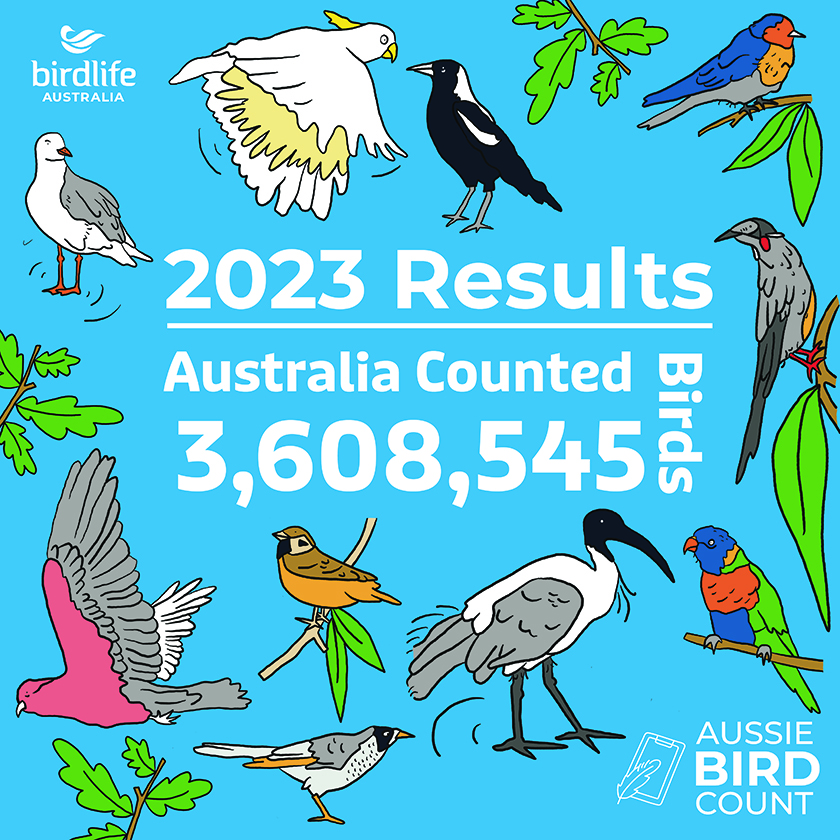A Decade of Rainbows – 10 years of the Aussie Bird Count
Tens of thousands connecting with nature in Australia’s largest citizen science event
From last October, 60,598 Australians across the nation turned their eyes to the sky to tally an astonishing 3,608,545 birds, with the colourful Rainbow Lorikeet continuing to hold the crown.
“Australia has undergone a lot of changes in the past decade, but the results of BirdLife Australia’s 10th Aussie Bird Count show that two things have remained constant in that time—Rainbow Lorikeets continue to rule the roost when it comes to counting Australia’s most common birds, and Aussies love to get out and connect with nature in the places where they live,” explains BirdLife Australia spokesperson, Sean Dooley.
When the Aussie Bird Count was first held in 2014, the Rainbow Lorikeet came in as number one by the 9,000 bird counters who took 20 minutes out of their week to do a survey using the Aussie Bird Count app in the places where they lived, worked or played. The second most counted bird was the Noisy Miner, a native honeyeater found in eastern Australia, followed by the Australian Magpie and Sulphur-crested Cockatoo. Over the next 10 years the number of Aussie Bird Counters grew to 60,000 in 2023 While the top four birds remained the same, in the ten years, only one bird has climbed into the top 10—the Australian White Ibis (also disparagingly known as the “Bin Chicken”) at the expense of the maligned introduced Common Myna.
“While it may seem as nothing much has changed with the birds we are most familiar with, if we had begun the Aussie Bird Count back in the 1950s or even the 1990s, the top 10 would have been quite different,” said Sean Dooley, BirdLife Australia’s National Public Affairs Manager.
“Birds tell us a lot about the environment we live in. In the past, there were few ongoing chances for long-term study of how populations of our most common birds are faring. The Aussie Bird Count has given us the chance to take a snapshot each year to help build a long-term picture. It will be fascinating to see the ranking of the top 10 birds are in the Aussie Bird Count in 10, 20 or 30-years’ time.”
“One thread linking the most successful birds that have been recorded living in the places where we live, is that they tend to be bolder, more aggressive species with a broad, generalist diet. We are picking up a decline in reporting rates of smaller, more specialist bush birds that were once fairly common garden birds such as Silvereyes, and fairy-wrens.
“The information we are collecting from the Aussie Bird Count is confirming what other research is showing about the challenges facing our native birds.”
The results of the Aussie Bird Count reflect a nationwide effort, with people contributing their time and energy into counting what they see above them in every state and territory of Australia. New South Wales led the count with 1,084,976 birds, followed closely by Victoria with 846,890 and Queensland with 872,204. Inspiring young minds, the event saw 877 schools join the count.
No state was more than Tasmania, it seems. Per capita, people in the island state were the keenest to count birds, followed by the ACT, Northern Territory and Queensland.
While the majority of participants counted birds in their own backyards, surveys came in from across the country including remote places like outback South Australia and offshore territories such as Christmas and Norfolk Islands.
Between us, Australians counted more than 3.6 million birds of 597 different species in the 2023 Aussie Bird Count.
In total, 597 different bird species were recorded during the Aussie Bird Count. Among the top 10 birds observed nationwide were, of course, the vibrant Rainbow Lorikeet in first place followed by the territorial Noisy Miner and iconic Australian Magpie.
Regionally, the top three birds varied across states and territories, showcasing the unique avifauna of each region. Based on the official results, Rainbow Lorikeets dominate the skies in NSW, VIC, QLD, and WA, while the majestic Magpie Goose reigns supreme in the Northern Territory. Each state and territory contributes valuable data to our understanding of bird populations.
BirdLife Australia relies on data to inform priorities and insights from the count help shape its broader Bird Conservation Strategy, aiming to halt bird extinctions by 2032 and overall bird declines by 2050.
The 2024 Aussie Bird Count will take place from 14-20 October.
Download the 2023 results infographic here.
Download the 2023 species list for Australia and the states/territories here.




Why we need you
Collecting a huge dataset like the one we get from the Aussie Bird Count is only possible thanks to you. The vast amount of data collected from citizen science programs like the Aussie Bird Count fills a knowledge gap, particularly on urban bird species, and gives us access to areas we usually wouldn’t be able to survey, like your backyard!
As well as helping ecologists track large-scale biodiversity trends like these, it also gives people the chance to connect with their natural environment and gain a greater appreciation of our unique fauna.
Count birds year-round
If counting birds for one week each October isn’t enough, and you’re keen to submit bird surveys year-round, you should check out our bird monitoring programs — Birds in Backyards and Birdata.


